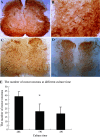The neuroprotective potential of phase II enzyme inducer on motor neuron survival in traumatic spinal cord injury in vitro
- PMID: 17912625
- PMCID: PMC11515017
- DOI: 10.1007/s10571-007-9219-0
The neuroprotective potential of phase II enzyme inducer on motor neuron survival in traumatic spinal cord injury in vitro
Abstract
(1) Phase II enzyme inducer is a kind of compound which can promote the expression of antioxidative enzymes through nuclear factor erythroid 2-related factor 2 (Nrf2) activation. Recently, it has been reported that these compounds show neuroprotective effect via combating oxidative stress. The purpose of this study is to determine whether phase II enzyme inducers have neuroprotective effects on traumatic spinal cord injury. (2) An organotypic spinal cord culture system was used, Phase II enzyme inducers were added to culture medium for 1 week, motor neurons were counted by SMI-32 staining, glutamate, Nrf2, and Heme oxygenase-1(HO-1) mRNA were tested. (3) This study showed motor neuron loss within 1 week in culture. After 1 week in culture, the system was stable. Moreover, Glutamate was increased when in culture 48 h and decreased after 1 week in culture. There was no significant change between 1 and 4 weeks in culture. Necrotic motor neuron and damaged mitochondrial were observed in culture 48 h. Furthermore, phase II enzyme inducers: tert-butyhydroquinone (t-BHQ), 3H-1,2-dithiole-3-thione (D3T), and 5,6-dihydrocyclopenta-1,2-dithiole-3-thione (CPDT) were shown to promote motor neuron survival after dissection, it was due to increasing Nrf2 and HO-1 mRNA expression and protecting mitochondrial not due to decreasing glutamate level. (4) The loss of motor neuron due to dissection can mimic severe traumatic spinal cord injury. These results demonstrate that glutamate excitotoxicity and the damage of mitochondrial is possibly involve in motor neuron death after traumatic spinal cord injury and phase II enzyme inducers show neuroprotective potential on motor neuron survival in traumatic spinal cord injury in vitro.
Figures





References
-
- Baptiste DC, Fehlings MG (2006) Pharmacological approaches to repair the injured spinal cord. J Neurotrauma 23(3–4):318–334 - PubMed
-
- Banik NL, Shields DC, Ray S, Davis B, Matzelle D, Wilford G, Hogan EL (1998) Role of calpain in spinal cord injury: effects of calpain and free radical inhibitors. Ann N Y Acad Sci 844:131–137 - PubMed
-
- Cao Z, Hallur S, Qiu HZ, Peng X, Li Y (2004) Induction of endogenous glutathione by the chemoprotective agent, 3H-1, 2-dithiole-3-thione, in human neuroblastoma SH-SY5Y cells affords protection against peroxynitrite-induced cytotoxicity. Biochem Biophys Res Commun 316(4):1043–1049 - PubMed
-
- Dykens JA, Stern A, Trenkner E (1987) Mechanism of kainate toxicity to cerebellar neurons in vitro is analogous to reperfusion tissue injury. J Neurochem 49(4):1222–1228 - PubMed
-
- Fahey JW, Talalay P (1999) Antioxidant functions of sulforaphane:a potent inducer of phase II detoxication enzymes. Food Chem Toxicol 37:973–979 - PubMed
Publication types
MeSH terms
Substances
LinkOut - more resources
Full Text Sources
Medical

